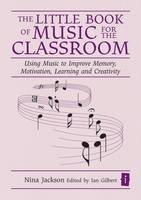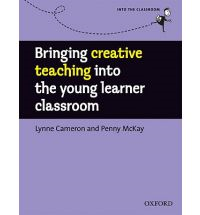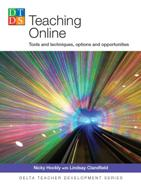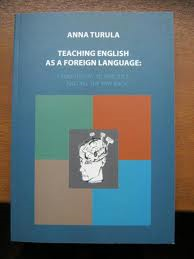Short Book Reviews
Hanna Kryszewska, Poland
Hanna Kryszewska is a teacher, teacher trainer, trainer of trainers. She is a senior lecturer at the University of Gdańsk, and EU Teacher Training College where she trains pre-service teachers. She is also Director of Studies at SWPS, Sopot, Poland. She is co-author of resource books: Learner Based Teaching, OUP, Towards Teaching, Heinemann, The Standby Book, CUP, Language Activities for Teenagers, CUP and a course book series for secondary schools: ForMat, Macmillan. She is also co-author of a video based teacher training course: Observing English Lessons. Hania is a Pilgrims trainer and editor of HLT Magazine.
E-mail: hania.kryszewska@pilgrims.co.uk

The Little Book of Music for the Classroom. N. Jackson. (2009) Crown House Publishing Ltd. . ISBN 978-184590091-5, pp148. This charming book is a pleasure to hold and to read. It is beautifully presented. It feels like a 19th century book of poetry rather than a book on methodology presenting sound research. Normally I don’t write about book prices but the price of £ 6.99 for this publication is really good value for money. The book focuses on “using music to improve memory, motivation, learning and creativity”. The chapters in the book focus on using music for learning, for relaxation and calm, for motivating, stimulating and energising, and finally for reaching an outcome. Each chapter gives some theoretical background, sample activities, a list of sample musical pieces to use and a summary of main points to remember. The book is deeply rooted in Suggestopaedia, Accelerated Learning and Brain Gym and is aimed at teaching in general not just EFL. The choice of music is supported by research on the effect the given type of music has on the human brain and there is the BMP ( Beat Per Minute) justification for each selection. I particularly like the ideas for using songs for Special Educational Needs (SEN) students who have speech problems like stammering and stuttering. The author also warns about choosing the right kind of music and in doing so the need to consider many factors. When you read the book you may feel that from now on the classroom should be filled with music. Yet there is a word of warning: “ silence can be golden and if you play the wrong music at the wrong time” you can go seriously wrong. I wish there was a CD that came with it. It seems that the book is aimed mainly at teachers of young learners but it is universal applicable to all age groups. Teachers who read it will also learn a lot for themselves as human beings as well as professionals.

Bringing creative teaching into the young learner classroom. L. Cameron and P. McKay (2010) OUP. ISBN 978-0-19-442248-2, pp 104. This book is one of the first publications in the new OUP series: Into The Classroom. It is different from the old well established OUP series Resource books for teachers. It is more snappy and sketchy than the old series. The books in the series are short practical guides aimed at teachers of 6-16 year olds who want to explore new teaching tools and techniques, or to become familiar with new educational policies and ways of implementing them in the classroom. The title in question focuses of child-centered approaches to creativity and presents 150 classroom activities, the rationale behind them, sample language of instruction to use in class and, finally, some tips in the Getting it right section. The activities themselves focus on challenging young learners, encouraging the students to learn, assessment, teaching pronunciation, elements of CLIL, using drama etc.. This is an excellent book for less experienced teachers of young learners.

Teaching Online. N. Hockly with L. Clanfield (2010) Delta Publishing. ISBN 978-1-905085-35-4, pp 112. The book belongs to the highly successful Delta Teacher Development Series. It deals with different aspects of teaching on line in a clear, accessible and reassuring way. It addresses three main areas: the forms teaching on-line and blended learning can take, the wealth of tools that are available (with no pressure that you have to use all of them) and ideas and techniques for effective on-line teaching. This book, like all the other books in the series, splits into three parts: 1. factual information and background, in this case, about available tools and sites, 2. a bank of activities and 3. further developments such as the teachers’ own development through PLN (Personal Learning Network). The authors have thought about everything including netiquette. The activities have a varying degree of technical complexity so every teacher will find something for himself or herself, even a complete novice to IT aided teaching. Some of the activities are well known and well established ELT activities with an IT facelift and upgrade, e.g. put captions or speech bubbles into visual material, dictagloss etc. It is reassuring that traditional methodology travels well. But, of course, there are exclusively IT based activities like using online concordancers or word clouds.

Teaching English as a Foreign Language: From Theory to Practice… And All the Way Back. A. Turula (2010) Wydawnictwo Wyższej Szkoły Lingwistycznej Częstochowa. Oxford. ISBN 978-83-61425-19-9, pp 470. This is an impressive book on the relationship between theory and practice and how they influence each other. Not surprisingly, it falls into two major parts: a theoretical part and a practical one. The former deals mainly with how humans learn languages, language acquisition theories, different kinds of learners and age variables, affect in language learning, classroom dynamics etc. The latter deals with various teaching methods, including a historical overview and description of the current state of affairs, teaching vocabulary and grammar, the four skills, and materials for language teaching. The book is sincere, serious and academic in its tone, and shows the author’s sound knowledge of the field. You can also see it when you look at the bibliographies at the end of each chapter listing up to 50. If you multiply it by the number of chapters in the book, you an imagine the extent of researching and reading the author has put into the writing of this book. I think it is an impressive and comprehensive publication, although the author admits that there are still some omissions she is aware of. However, I wonder who the addressee of the book is. A BA student, CELTA trainee or pre-service teacher may find it too hard to follow because of its extensiveness and the very academic language used by the author. So it probably leaves DELTA trainees and trainers, academics in the field of ELT methodology and sophisticated MA students with good command of English. ( NB. I am thrilled to see that HLT and Pilgrims trainers are quoted in the book )

Please check the Methodology and Language for Primary Teachers course at Pilgrims website.
Please check the Teaching through Music and Visual Art course at Pilgrims website.
Please check the Basic IT in the Classroom course at Pilgrims website.
Please check the Using Technology in the Classroom – Level 2 course at Pilgrims website.
Please check the Train the Trainer course at Pilgrims website.


|